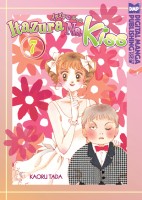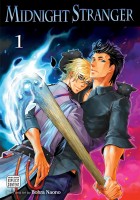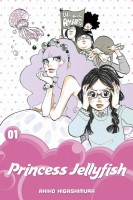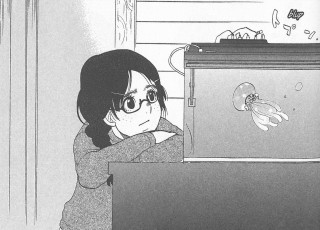My News and Reviews
As I alluded to a few months ago, I’ve been in the process of trying to purchase a house. Well, I finally made it happen! I signed all of the papers on Friday, so for the foreseeable I’m going to be a little preoccupied getting things ready and moving over to the new place. It’s all sorts of exciting, but it does mean I’ll have significantly less time to devote to other things for a while. And so, I’m back to a reduced posting schedule at Experiments in Manga for the time being. Expect to continue to regularly see My Week in Manga, but there will probably only be one other review or feature most weeks. That all being said, last week I reviewed the recently released Midnight Stranger, Volume 1, a supernatural boys’ love manga with a sense of humor (as well as some pretty great monster designs) by Bohra Naono. I haven’t seen a lot of manga news over the last week, although I’m sure there has been some, but I did want to mention that Viz Media has licensed Kohske and Syuhei Kamo’s Gangsta: Cursed, a prequel series to Gangsta (a manga of which I’m particularly fond.)
Quick Takes
 Itazura na Kiss, Volumes 7-8 by Kaoru Tada. It’s been a little while since I’ve read any of Itazura na Kiss, but it’s a pretty easy series to put down and pick up again since nothing of major importance really ever seems to change all that much. I have been enjoying the series, but I’m starting to long for a little more forward momentum and the characters are beginning to wear me down a little. At the same time, while the overall pacing is fairly slow, Tada is expert in changing and moving the story along just enough to keep things interesting. Kotoko and Naoki are now newlyweds, but otherwise their relationship is pretty par for the course. Kotoko is utterly infatuated with Naoki, and Naoki continues to be fairly cold towards her. Thankfully, Kotoko is (slowly) beginning to mature and determine for herself what it is she really wants to do with her life. It can be difficult to tell at times, but Naoki really does love Kotoko and cares for her well-being, he just tends to be a total ass about it which can be tiresome. Granted, it does make it particularly satisfying when he ends up being thrown out of his comfort zone.
Itazura na Kiss, Volumes 7-8 by Kaoru Tada. It’s been a little while since I’ve read any of Itazura na Kiss, but it’s a pretty easy series to put down and pick up again since nothing of major importance really ever seems to change all that much. I have been enjoying the series, but I’m starting to long for a little more forward momentum and the characters are beginning to wear me down a little. At the same time, while the overall pacing is fairly slow, Tada is expert in changing and moving the story along just enough to keep things interesting. Kotoko and Naoki are now newlyweds, but otherwise their relationship is pretty par for the course. Kotoko is utterly infatuated with Naoki, and Naoki continues to be fairly cold towards her. Thankfully, Kotoko is (slowly) beginning to mature and determine for herself what it is she really wants to do with her life. It can be difficult to tell at times, but Naoki really does love Kotoko and cares for her well-being, he just tends to be a total ass about it which can be tiresome. Granted, it does make it particularly satisfying when he ends up being thrown out of his comfort zone.
 The Judged by Akira Honma. Having greatly enjoyed the first two volumes of Honma’s Rabbit Man, Tiger Man boys’ love series, and considering the fact that the third and final volume is unlikely to ever be released in English, I decided to seek out the creator’s other works in translation. I didn’t realize it until I finished reading manga, but The Judged was actually Honma’s first volume to be released as a professional mangaka. The titular story is about a prosecuting investigator and member of the Diet who are navigating a political scandal, while their shared past makes things even more complicated. The Judged also includes Honma’s debut manga “Like a White Phantom” about an initially antagonistic relationship between two young doctors. For the most part, the focus of The Judged is more on the drama and less on the romance. The manga tends to be fairly serious and the relationships aren’t necessarily the most healthy. They’re not always particularly happy relationships, either. Many of the characters have some pretty heavy personal issues do deal with, including physical and emotional abuse.
The Judged by Akira Honma. Having greatly enjoyed the first two volumes of Honma’s Rabbit Man, Tiger Man boys’ love series, and considering the fact that the third and final volume is unlikely to ever be released in English, I decided to seek out the creator’s other works in translation. I didn’t realize it until I finished reading manga, but The Judged was actually Honma’s first volume to be released as a professional mangaka. The titular story is about a prosecuting investigator and member of the Diet who are navigating a political scandal, while their shared past makes things even more complicated. The Judged also includes Honma’s debut manga “Like a White Phantom” about an initially antagonistic relationship between two young doctors. For the most part, the focus of The Judged is more on the drama and less on the romance. The manga tends to be fairly serious and the relationships aren’t necessarily the most healthy. They’re not always particularly happy relationships, either. Many of the characters have some pretty heavy personal issues do deal with, including physical and emotional abuse.
 Persona Q: Shadow of the Labyrinth, Side: P3, Volume 1 by So Tobita. The Persona series is perhaps the most popular subset of the larger Shin Megami Tensei video game franchise. Persona Q is a relatively recent spinoff from 2014 made for the Nintendo 3DS which combines characters from Persona 3 and Persona 4—a player can choose to experience the game from either perspective. Likewise, a reader can choose from either the Side: P3 or Side: P4 manga adaptation which present two different sides of the same story. When it comes to manga adaptations of video games, there seem to be two major types, those that are accessible to anyone and those that are intended to be appreciated by fans of the original. So far, the Side P3 manga would seem to be one of the latter, requiring some prior knowledge of the franchise to fully enjoy the series. Very little is explained about the world or the characters in the manga itself. But for those who are familiar with Persona, the Side: P3 manga can be a fun way to quickly experience or re-experience the story and game of Persona Q, though I’m not sure that it really adds anything new.
Persona Q: Shadow of the Labyrinth, Side: P3, Volume 1 by So Tobita. The Persona series is perhaps the most popular subset of the larger Shin Megami Tensei video game franchise. Persona Q is a relatively recent spinoff from 2014 made for the Nintendo 3DS which combines characters from Persona 3 and Persona 4—a player can choose to experience the game from either perspective. Likewise, a reader can choose from either the Side: P3 or Side: P4 manga adaptation which present two different sides of the same story. When it comes to manga adaptations of video games, there seem to be two major types, those that are accessible to anyone and those that are intended to be appreciated by fans of the original. So far, the Side P3 manga would seem to be one of the latter, requiring some prior knowledge of the franchise to fully enjoy the series. Very little is explained about the world or the characters in the manga itself. But for those who are familiar with Persona, the Side: P3 manga can be a fun way to quickly experience or re-experience the story and game of Persona Q, though I’m not sure that it really adds anything new.







